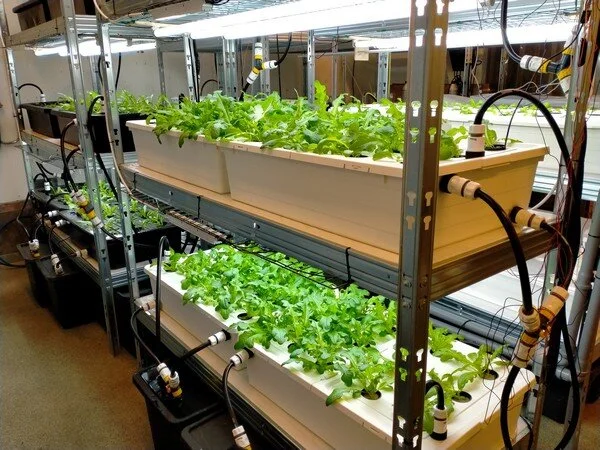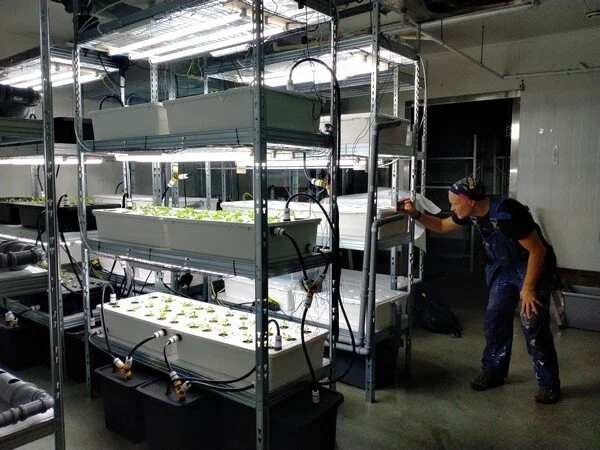
Welcome to iGrow News, Your Source for the World of Indoor Vertical Farming
An Affordable Solution To Monitor And Optimize Food Production
Ecobloom, a startup based in Stockholm, provides two different solutions to the vertical farming space. The first solution is a B2B product, namely an AI solution ensuring automated growing of the plant and monitors plant food production at the same time
By Rebekka Boekhout
July 9, 2021
“We’re helping farmers optimize their food production through more efficient yield management,” says Hamza Qadoumi, CEO and founder of Ecobloom. “Also, cost reduction comes in through a significant reduction in labor and yield increases up to 2 times more per year through accurate predictions. The system allows us to reduce food waste up to 20% through yield prediction and our deviation analysis.”
Ecobloom, a startup based in Stockholm, provides two different solutions to the vertical farming space. The first solution is a B2B product, namely an AI solution ensuring automated growing of the plant and monitors plant food production at the same time. With already a successful consumer product on the market, their focus is to offer smart technology solutions for the indoor farming market.
The pilot farm
Smart sensor - EcoSense
The company provides a software-connected plug-and-play solution named EcoSense. EcoSense is a small box that can basically be placed anywhere on the farm, such as above shelves to monitor plant growth. EcoSense comes in two formats: a camera for growth and plant analysis, sensors for water analysis and sensors for air analysis. Next to that the sensors predict yield, so lots of data can be gathered to keep improving this. Hamza notes, “We’re now looking at venturing with flowers and fruit greenhouse growers in Spain, Holland, The UK and the Middle East region.
The core solution of the device is hardware, sensors and cameras. Through these elements, the environmental sensors and plant environment is captured by data collectors and cameras throughout the plant’s life cycle. According to Hamza, farmers need about 1 device per 100m2. The wifi-connected cameras and sensors are modular solutions, using machine learning to constantly monitor and analyze plant development, health and stress. Through camera recognition, a certain yield outcome and deviations can be predicted.
Read the rest of the article here
For more information:
Hamza Qadoumi, CEO and founder
Ecobloom
hamza@ecobloom.se
www.ecobloom.se
"New Tabletop Growing System Requires Much Lower Capital Investment"
Plantlogic is focused on developing and producing containers and growing systems for substrate agriculture
Introducing "Plantlogic’s hi-grow system"
Plantlogic is focused on developing and producing containers and growing systems for substrate agriculture.
"The benefits of tabletop strawberry production are well known – boosting yields using substrate techniques and reducing labor costs. However, the capital investment needed for the most common system, metal gutters, can be a major barrier to the expansion of this growing system," they have seen.
"Furthermore, the substrate in slabs compromises many of the benefits of substrate production. Still, other tabletop systems compromise plant health by creating continuous troughs of the substrate with uneven drainage or sealing roots into a closed space."
For the past four years, Plantlogic has been developing a totally new tabletop growing system that seeks to reduce the capital investment while continuing to create optional conditions for roots to thrive. The result of these years of testing, design failures, and successes is the “Hi-Grow System”.
"Available in a variety of configurations including for troughs/pots, for slabs, with and without drainage collection. Now growers can enjoy the benefits of substrate tabletop production without compromising benefits with a much lower capital investment," they say.
Specific advantages of using Plantlogic’s Hi-Grow system are first, that it benefits from tabletop production at a lower cost. "Secondly, it supports troughs/pots, as the pots provide the best conditions for root development with a fixed volume, carefully controlled drainage, and oxygen uptake holes, making irrigation easier."
"Besides, it enables growers to do develop plants in the same container in a high-density nursery environment then move tabletops for fruit production. Growers can save money by using bulk substrate or enable the use of the blended substrate. Finally, growers can avoid labor for removal or pollution from the plastic film around slabs, and the truss support is included in the pots," they continue.
This solution supports the use of traditional substrate slabs. Also, drainage is collected into a narrow gutter. Growers can reduce risks by separating plants from drainage and other containers, as the trough is not continuous.
For more information:
Plantlogic
sales@getplantlogic.com
www.getplantlogic.com
17 Jun 2021
Fruitbox 56 - Daniel Kats, InFarm
Despite its name, InFarm’s roots are very much in the market. In February 2021, the Berlin-based urban farming startup announced the creation of new growing centres to supply fresh produce to the likes of Edeka, Lidl and Kaufland
5th March 2021
The Urban Farming Startup's Head of Sales
Tells Fruitnet About The Next Stage of its Impressive Expansion
Despite its name, InFarm’s roots are very much in the market. In February 2021, the Berlin-based urban farming startup announced the creation of new growing centres to supply fresh produce to the likes of Edeka, Lidl, and Kaufland.
Starting in Germany and extending very soon to the UK, Netherlands, France, Switzerland, US, and Canada, the move represents a step-change in its operations, scaling up a business model that until now has focused on smaller, plug-and-grow units within retail stores themselves.
Now, as demand for locally grown produce continues to rise, the company is preparing go beyond the 1,500 in-store farms already installed and ramp up production wherever the market demands it.
And with total venture capital funding of more than US$400m to date, it’s certainly shaping up to be one of the world’s most hotly tipped vertical growing startups.
“We are not building farms,” explains InFarm’s vice-president of corporate sales Daniel Kats, speaking on the latest episode of Fruitbox. “We’re taking facilities and deploying models inside. Those automated towers can then grow by demand. If the retailer has more demand, we just add one or two or ten more towers.”
Why now? “The population is growing, the demand keeps growing, and a lot of food production is needed in many large cities,” says Kats. “Therefore we are pushing the button now and starting to grow.”
Now operating in ten countries, and set to launch in Japan this year, the company is also venturing into new products. As a result, it’s ready to become a major supplier in its own right, rather than simply enabling retailers to grow a limited number of items in stores.
“We are growing much more variety and assortment,” Kats adds. “We started with a lot of leafy greens, herbs, lettuces, mixed salads, microgreens, and now we’re doing the first steps into tomatoes, mushrooms, chillies, strawberries in the future, which require naturally much bigger spaces to grow centrally and distribute to the supermarkets.”
Hosted by Chris White in London, Fruitbox now attracts a big audience across the global fruit and vegetable business that tunes in every week to hear exclusive interviews and expert analysis. Produced by Fruitnet Media International, the show is essential listening for everyone in the fresh produce industry.
All previous episodes of Fruitbox can be found on any of the following podcast services:
Apple · Spotify · Anchor · Google · Overcast · Soundcloud · Stitcher · Pocket Casts
Produced by Fruitnet Media International, the show is essential listening for everyone in the fresh produce industry.
To find out how you can tell your story on Fruitbox, email: chris@fruitnet.com
To learn about sponsorship and advertising opportunities, email: advertising@fruitnet.com
Enjoyed this free article from Eurofruit Magazine and its team of editors? Don't miss out on even more in-depth analysis, plus all the latest news from the fresh produce business. Subscribe now to Eurofruit Magazine.
Vertical Farming Is Coming To A Store Near You
Indoor farms, and even in-store farms, are fulfilling our need for more local vegetables. These semi-autonomous vertical farms offer fresh, healthy food options by bringing food production closer to consumers
September 9, 2020
by Julien Muller, Maxime Cailler
Inadequate consumption of fruits and vegetables is among the top 10 risk factors for our health. Eating fruits and vegetables daily helps prevent major diseases, ensures an adequate intake of most micronutrients and fibers, and can help displace foods high in saturated fats, sugar or salt.
The health benefits of eating more produce can’t be denied, but what about the old adage “fresh is best”? Locally grown fruits and vegetables have distinct advantages. The less time it takes to get to your plate, the better. Once vegetables are picked and harvested, they begin to lose their nutrients. Also, produce that is grown and sold locally has minimal transportation time, which translates to reduced fossil fuel emissions.
It may soon be common for anyone to pluck a farm-fresh tomato from the vine or choose their lettuce while it’s still growing, even if they live in urban areas without gardens. Indoor farms, and even in-store farms, are fulfilling our need for more local vegetables. These semi-autonomous vertical farms offer fresh, healthy food options by bringing food production closer to consumers.
Vertical farms use state-of-the-art technologies, such as specialized LEDs, to help the vegetables grow. Simulation is used to strategically design and optimize indoor farm lighting to create an optimal environment that decreases growing times.
Vertical Farming Lighting Challenges
Engineers designing in-store vertical farms must consider many optical aspects.
First, for a row containing a certain type of plant, it is important to ensure the right illumination value. Different plants need varying amounts of light to grow, and that amount can vary during the growth cycle.
It is also important to ensure illumination homogeneity through a row so all the seeds grow at the same speed. This eases the burdens of plant care during production and allows harvests to be scheduled as needed.
Similarly, when it comes to the light spectrum, plants don’t need all the wavelengths of natural light to grow. Plants respond best to just the red and blue wavelengths, so traditional lamps mimicking sunlight are a waste of energy. Careful optical design can help to optimize LED lighting to target only necessary wavelengths, saving energy in the process.
Lastly, the amount of light absorbed by the plants should be maximized. The less light plants reflect, the faster they grow, which reduces energy consumption.
Vertical Farms Grow with Simulation
LED lights are the most efficient, effective, and customer-friendly way to illuminate plants indoors. They use low energy, produce little heat, and can be color-optimized for growth.
To show how Ansys SPEOS can be used to design grow-light LED array solutions and simulate an indoor farm, we designed a generic light array with 90 LEDs. According to the literature, a diffuse purple spectrum (containing no green light) is optimal for plant growth. Plants reflect much of green visible light and absorb the rest of the spectrum. Consequently, the light array we created has 45 LEDs in the blue spectrum and 45 LEDs in the red spectrum, combining to make purple.
Grow light array for a purple spectrum
Inside our farm, we first designed eight rows of 15 lettuce plants. Each row is illuminated by three of our purple spectrum light arrays.
Vertical farm isometric (left) and side view.
To take the optical properties (light absorption and reflection) of the lettuce into account, we measured some leaf samples using Ansys’ Portable Optical Measurement Device (OMD). The bidirectional reflectance distribution function (BRDF) obtained was applied to all of the lettuce plants in the geometry.
We then used light simulation to measure and visualize illuminance homogeneity, as well as the vegetables’ light absorption. The results obtained for the first design are shown below.
Illuminance sensor (left) and 3D absorption (right)
We could see that the illumination was not homogeneous on the whole row. We then iterated on the LED array’s position, the spectrum of the LED, and the material of the walls of the vertical farm to produce the most efficient solution.
Vertical Farming Simulation Results Are Illuminating
We spaced the luminaires more evenly and gave more space between the LED arrays and lettuce plants. We also changed the materials on the sides and the back from transparent (absorbing) to white (diffusing). The front of the vertical farm was kept transparent so consumers could see the plants as they shopped.
Vertical farm isometric (left) and side view.
Our next simulation showed that the illumination reaching the lettuce plants is more evenly distributed, producing a more uniform light absorption, as shown below.
Illuminance sensor (left) and 3D absorption (right)
However, the lettuce plants in the front and back are a bit less illuminated, so they might not grow as well as the ones in the center. Because the simulation results are so visually striking, it’s easy to determine where the vertical farming design could be improved. One idea for the front lettuce plants would be to apply a partially reflective coating on the inside face of the front glass to reflect more light toward them. The optimized system would then both ensure an optimal harvest yield and optimal energy consumption.
Vertical farming for in-store produce is an idea making its way to the mainstream. Optical simulation helps quantify and visualize the benefits of vertical farms, such as using less energy and water, and growing what is needed in small batches, which wastes less food.
Learn more about optical simulation and Ansys SPEOS.
The Race Is on To Grow Crops In The Sea And Feed Millions of People
With the quality of arable land declining and seawater encroaching on fertile cropland, researchers are trying to find a way to make crops grow in seawater
With the quality of arable land declining and seawater encroaching on fertile cropland, researchers are trying to find a way to make crops grow in seawater
17 June 2020
Chen Hanquan / WIRED
In December 2015, as representatives from United Nations member states were finalizing what would become the Paris Agreement on climate change, Duncan Cameron stood before a crowd of delegates and warned them about an environmental catastrophe happening right beneath their feet.
A soil biologist and co-director of the University of Sheffield’s Institute for Sustainable Food, Cameron had long known that the amount of farmland capable of growing nutrient-rich crops was shrinking, but he didn’t know how fast. For the previous year, Cameron’s team had analyzed the scattershot data available on arable land loss, and what they found was disturbing: in the past four decades, the world lost up to one-third of its arable land to soil degradation and resulting erosion. Without alternatives, already fragile agricultural systems are on the verge of collapse, raising the prospect of a world filled with farms that can’t grow enough food.“
It’s quite a terrifying amount,” Cameron says. “We hear that we can solve a lot of these problems in terms of food insecurity by wasting less and getting more efficient, but that isn't going to give us everything we need.” Now, an emerging group of startups and researchers are convinced that answers to the impending food crisis may not lie on land at all – instead they’re looking to the ocean and to feed future populations with crops grown on floating farms and fed by seawater.
These ambitious initiatives target a thorny mess of environmental and humanitarian issues — freshwater and land scarcity, global hunger, crop security, and agriculture’s enormous carbon footprint amongst others — but the scientific and logistical challenges they face are enormous. In a field where there are few easy answers, one problem looms above all others: what do we do about all the salt?
Soil scientists and farmers have waged war against salt for decades. As sea levels rise, salt levels are creeping up in the rivers and underground aquifers that irrigate fields – particularly those low-lying areas close to vast river deltas. Across the world, farmland is drying out which raises salt levels and interferes with nutrient uptake and damages tissues. Excessive salt causes massive global crop loss — an estimated £21.7 billion each year — and that's expected to increase as factors like sea level rise and higher-intensity weather events driven by climate change push ocean water further into farmland, hitting the poorest coastal communities hardest.
Once there, salt requires significant resources to remove from soil — the most common methods involve large amounts of freshwater, which is already scarce for an estimated four billion people worldwide — sending researchers on a long-running race to find staple crops that can grow despite constantly increasing salinity. Several countries including China, India, the Netherlands, and the United Arab Emirates have developed crop varieties that can withstand some soil salinity, but the real white whale is a staple crop that can thrive regardless of how much seawater is thrown at it.
“In principle, it could be done, but it's complicated,” says Exequiel Ezcurra, a plant ecologist at the University of California, Riverside who studies desert and ocean ecosystems. Ezcurra says that creating seawater-tolerant crops would require at least one, and possibly both, of the basic biological mechanisms plants like black mangroves have adapted to survive in salty waters. One mechanism is freshwater filtration in the roots, which for staple crops would require fundamentally altering the root’s dermal tissue to keep salt out. The other is specialised glands in the leaves that excrete salt as the plant pumps seawater throughout its system.
Changing a staple crop to have either mechanism is a challenge so big, many researchers aim for far more modest gains in salt tolerance and aren’t yet gunning for crops that grow in straight seawater. Plant breeders have been working on salt-resistant crops for decades but in rice – a crop notoriously sensitive to salinity – even the most salt-resistant varieties can’t cope with anything like the saltiness of seawater. “I'm not saying that nobody will be able to do it. Probably somebody will at some point,” Ezcurra says. “I simply have never seen a patent or anybody being able to do that” now.
Luke Young and Rory Hornby filed for a provisional patent in February for a technology they believe will break the seawater tolerance barrier. Young and Hornby are the cofounders of Agrisea, a Canadian startup that’s working to develop gene-edited salt-tolerant crops with the goal of soon growing them in floating farms placed in sea-flooded plains or anchored directly in the ocean.
Agrisea’s proposed method involves first isolating stem cells from crops like rice, then using CRISPR gene editing technology to insert a DNA sequence specialised to the plant. The sequence targets one of eight different genes, each chosen because the only place in nature where all eight are “switched on” is in plants that have naturally adapted saltwater tolerance. The sequence alters how the gene expresses, then stem cells are grown into a full plant that produces its own seeds armed with the newly edited gene. Follow the same process for editing the remaining seven genes, and the Agrisea team says you’ll have a plant that can grow in the salty sea without fertiliser, freshwater, or pesticides.
Many researchers have edited single genes for salt tolerance, but editing a gene network is an approach Young and Hornby say are unique to Agrisea. But they’re not at the finish line yet. Thus far, Young and Hornby are working to grow rice plants in water one-third the salinity of seawater and plan to have small farms floating off the shores of Kenya and Grand Bahama Island by the end of the year. Young says that he’s confident the process will work because similar strategies have been used in the past to gene edit plants for other traits and “because I'm not proving something, I'm copying something. I'm copying what nature has already been able to do.
”Julia Bailey-Serres, director of the Center for Plant Cell Biology at the University of California, Riverside, studies crop resilience and the molecular physiology of rice. She says that researchers routinely edit plants to knock out a gene’s function, but editing in a way that changes specific amino acids, which likely would be required for growing crops in the ocean, has only been done by a few researchers worldwide and not yet for the purposes of salt tolerance. That more granular type of editing will become more feasible in the future, she says, ”but I don't know if that’s going to be in two years or 10 years.”Bailey-Serres adds that she would be excited to see Agrisea succeed and that any tolerance increases beyond one-third ocean salinity would be a huge win in places like Vietnam and Bangladesh where rice paddies are bombarded with seawater.
Agrisea’s approach to arable land scarcity relies on cracking the salt tolerance problem, but other teams are opting to sidestep the issue entirely. Floating farms that reduce demand for arable land have long been key to survival in many non-Western nations. These crops thrive in freshwater bodies — like Myanmar’s Inle Lake, which locals have relied on for food possibly since as early as the nineteenth century — in buoyant beds that bob along the surface as monsoons and floods sweep through. Floating farms have also gained interest in Western cities. Over the last few years, research groups and architectural firms in the UK, Spain, and Italy amongst others have produced designs for floating vertical farms and greenhouses that suck up seawater from the outside and desalinate it to nourish hydroponic crops grown inside.
These projects push crops out into the ocean, but Yanik Nyberg’s strategy is to bring the ocean in. Instead of making new space for crops offshore, Nyberg’s Scotland-based company Seawater Solutions takes degraded coastal farmland, seeds it with naturally salt-tolerant herbs like samphire and sea blite, then floods the area by removing seawalls or pumping in water from the ocean to create an artificial salt marsh. In this new wetland ecosystem, crops grow without fertilisers, pesticides, or freshwater. They also hold soil in place, preventing erosion, and feed on nitrates and carbon, both of which over-accumulate in waters near human populations due to factors like agricultural runoff and CO2 emissions. A solar-powered irrigation system recycles the remediated water back to its original source.
















